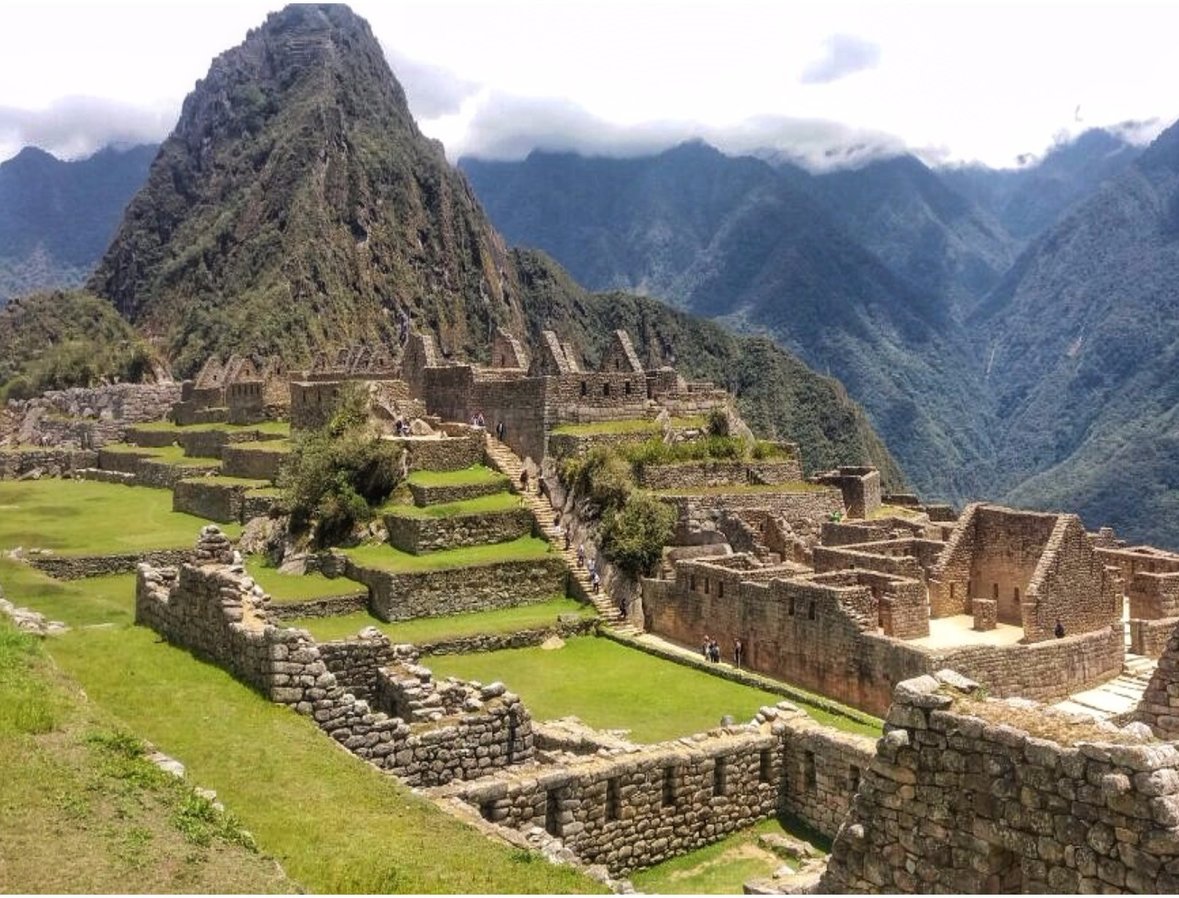(Check out Part I of this blog entry HERE)
Inca Trail Day Three: Winay Huayna & Intipata
So, day three of the Inca trail. After the challenge of Dead Woman’s Pass, we were told that day three would be both easier and more enjoyable. It certainly started well: we were treated to a lie-in until 6:00am! As a troubled sleeper, I was definitely feeling the previous 3:45 and 5:00 am starts, but it was still hard not to feel upbeat on what was widely rumoured to be the best day of the trek.
We began with what our guides described as a “gentle” ascent. Perhaps it was, but after the struggles of day two, my legs were achingly sore. The ascent didn’t feel too gentle too me, but after a short while the scenery was so astonishing I stopped noticing
Day three takes you through what are essentially several micro-climates, the first one being a cloud forest. Why are they called cloud forests? Turns out, because you’re like, actually in a cloud!
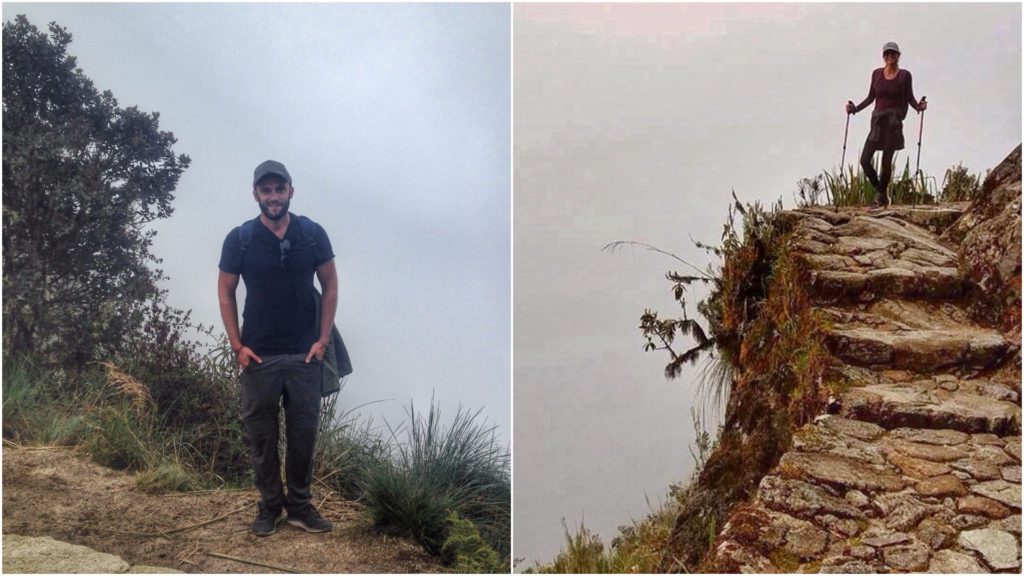
We trekked along narrow pathways, on one side fern-covered rock, on the other, a sheer drop down to the forest canopy below. We made our way down an ancient dark tunnel carved through rock, thick with the musty smell of bat droppings. I know I mentioned this in part one, but there’s something so evocative about being somewhere that hasn’t changed for half a millennia. The Incas would have walked along this exact path, seeing precisely what we were seeing – the only difference is that they didn’t have walking poles and boots to help them out (or, erm, porters).
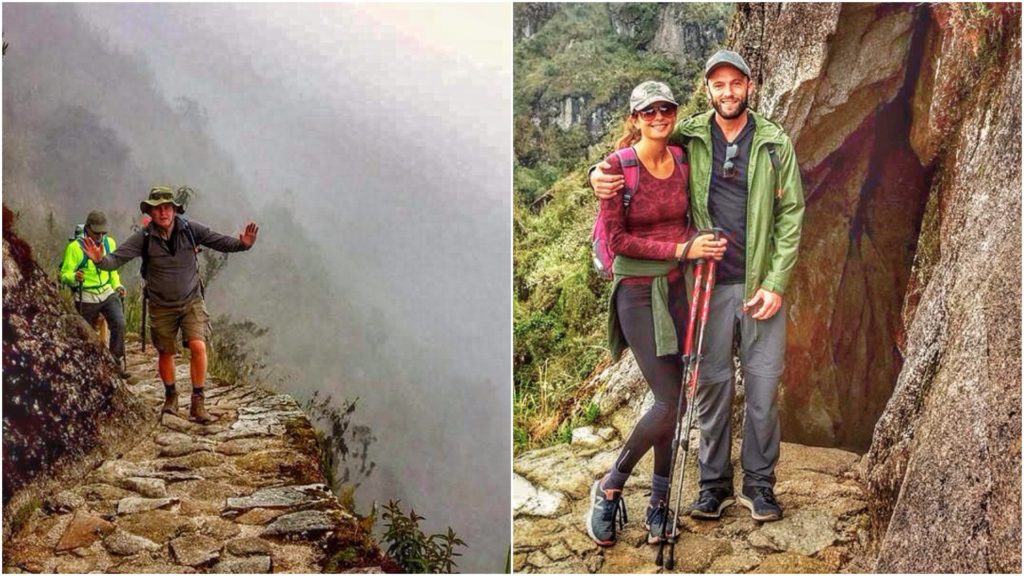
Day three also took us past several stunning Inca ruins, each more impressive than the last. The first one was Phuyupatamarca, which was literally positioned in the clouds. My photos don’t do it justice, but looking out onto the clouds rising like steam from the surrounding mountains was so beautiful you feel you have to pinch yourself. Beach scenes of turquoise waters and white sand are all very well, but give me dramatic, enigmatic mountains any day of the week.

Once we left Phuyupatamarca, the scenery changed again. We followed a long path along steep Andean forests, and after a knee-shaking descent down Inca steps worn slippery from years of feet, mountain finally gave way to jungle. The views here were so sensational part of you didn’t even want to capture it, because you know the image will be nothing compared to the reality.
Sometimes there were gaps in the foliage where you could look out onto the valley below and the wall-like mountains encircling you; other times the tree cover was so thick that only weak green light dropped through. Exotic flowers swayed at the touch of whirring hummingbirds, but not a stir of wind broke the enchantment.
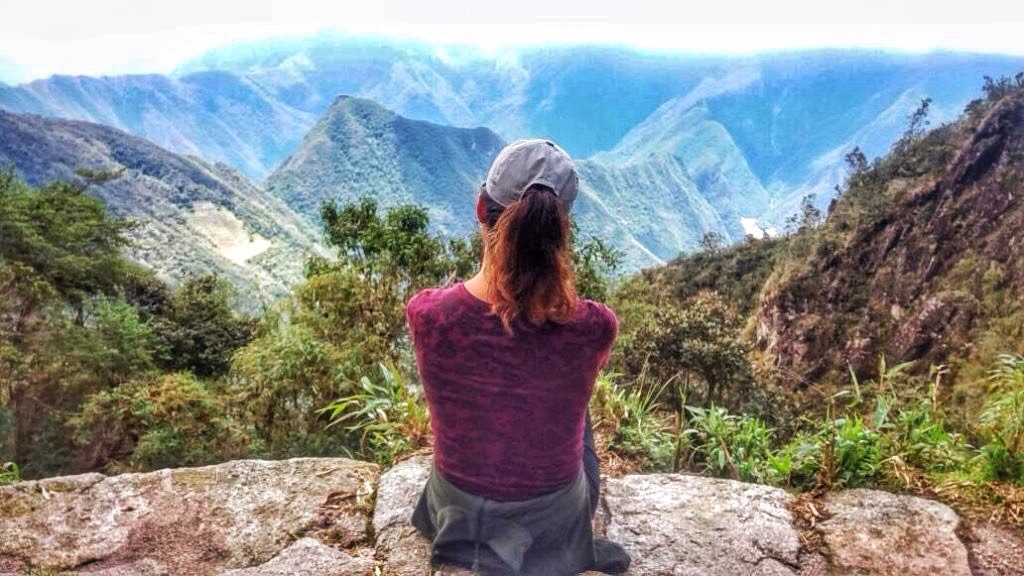
The next Inca ruin we came across was Intipata, a mainly agricultural site with grassy terraces perched over a dramatic gorge and narrow river. The wonderful thing about the Inca trail is that each time you think you’ve seen the most beautiful ruin, the most impressive view, the most dramatic scenery, you turn a corner and are proved wrong in the most exquisite way.
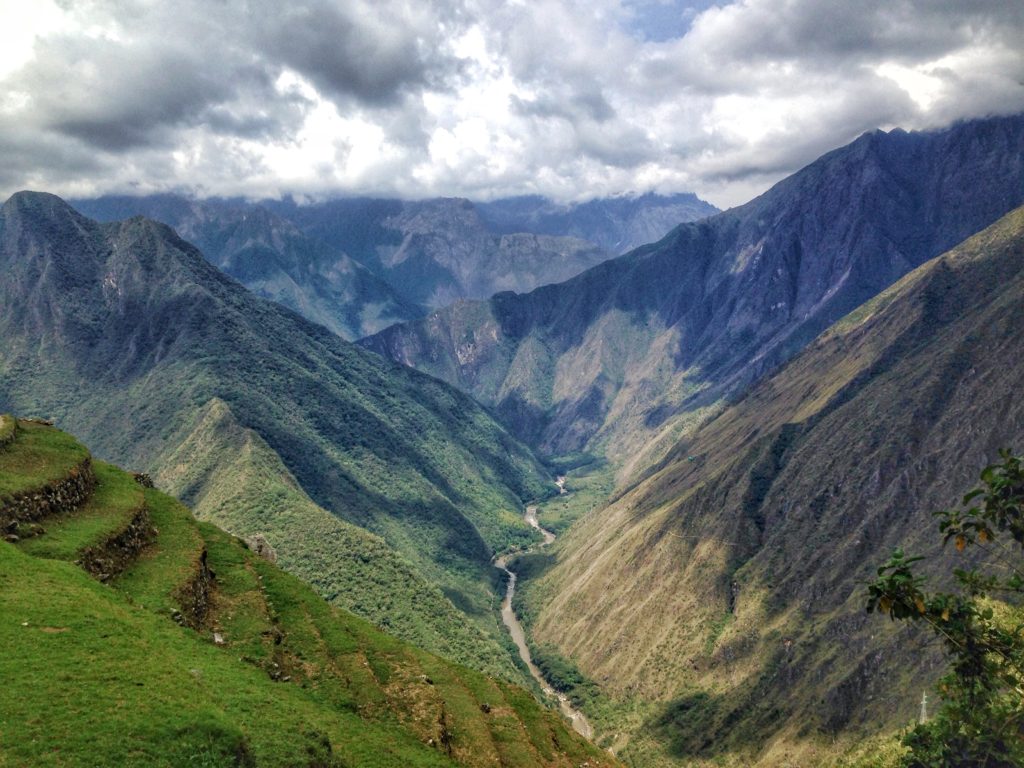
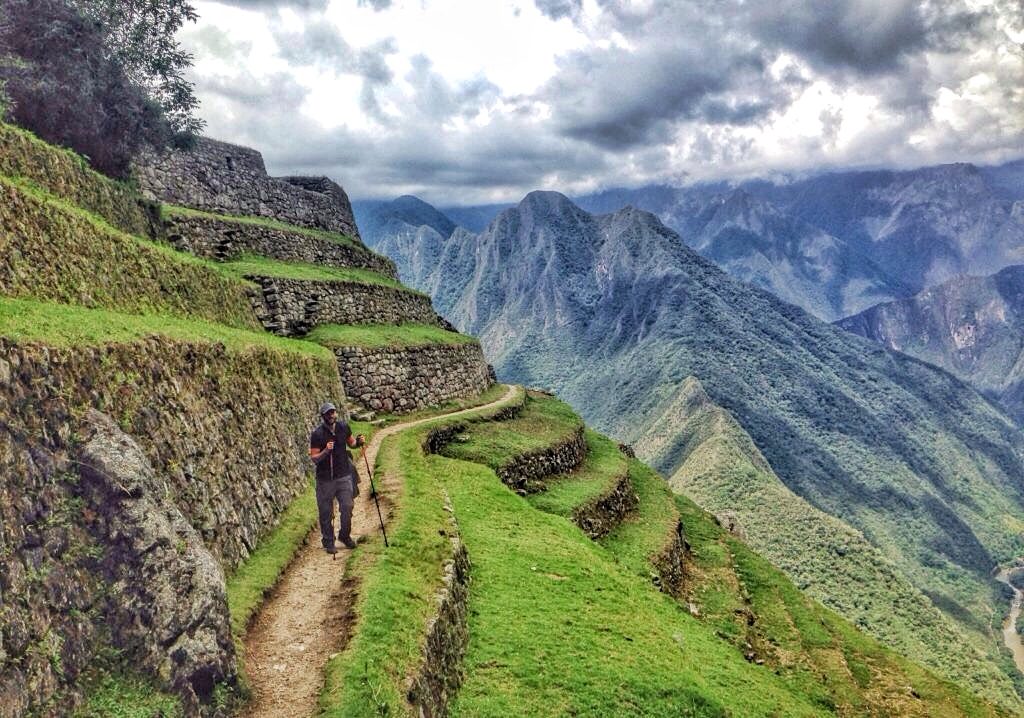

After making my way down the gazillion steps, winching at each one, we had time to enjoy the view and take some photos – though unfortunately the obligatory ‘jump-in-front-of-a-cool-view’ backpacker photos were out of the question for me due to my sore legs. Here’s Tom representing:
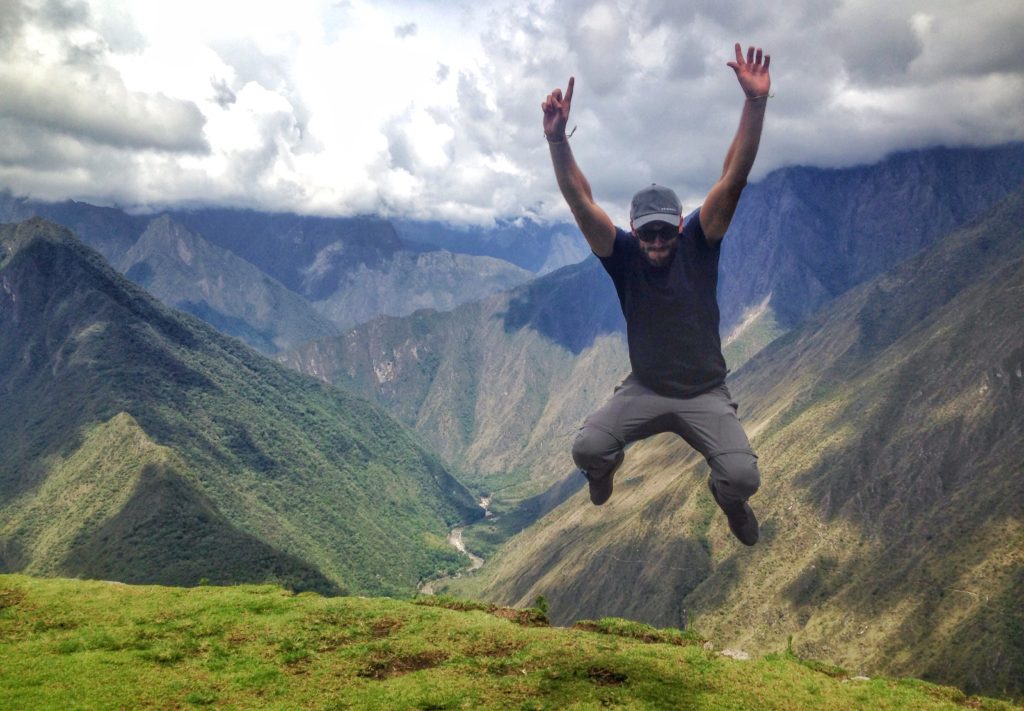

Our final campsite was just around the corner – as was Winay Huayna, the last Inca site we would explore before Machu Pichu itself. Sadly I was so wiped at this point that I only have a few photos. Winay Huayna, however, was definitely the most awe-inspiring site we’d seen yet, with frolicking llamas popping their heads up for cheeky photo opportunities.
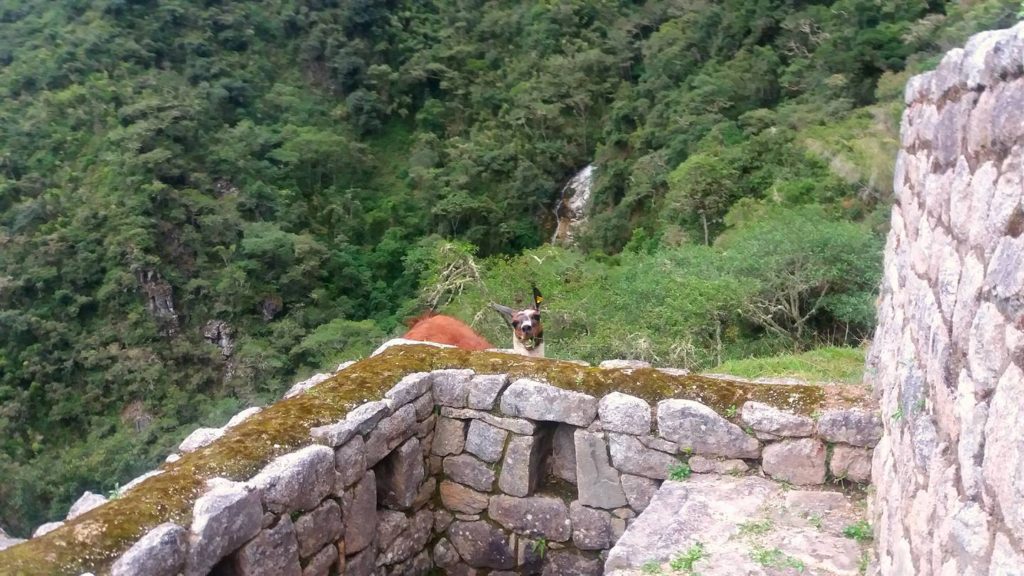
We had a wonderful last meal, and I mean wonderful: the chef even baked a cake. Using camping equipment. Amazing! During our last supper, I felt so grateful that we had such a lovely team. It made a huge difference to our overall experience, because honestly, not everyone’s so cool.
The Inca trail is busy. Though departures are staggered, inevitably you end up bumping into other groups from time to time. While most are nice, there was one exception: the green team, a bunch of twenty-something Brits and Americans who had an almost impressive disregard for other people. Several times they caught us up, screeching over our softly-spoken guides’ careful narration with waves of shouty obnoxiousness. It was so rude. I took a stand the only way a Brit can – tutting loudly – and hoped day three would be the last I’d see of them.
Now for the only real negative of the Inca trail: the toilets. I’ve travelled long enough now that I’ve developed an aptitude for gross toilets, but this was something else. You’re camping, so they’re squat toilets, which in itself is fine – though let it be said that the very act of squatting in the dark, when your thighs are screaming and your knees are shaking, is no mean feat. But these toilets were seriously full on disgusting. It’s not Llama Path’s fault, as the campsites are used by all the companies, but you’re better off using what our guides called “puma toilets” (a bush).
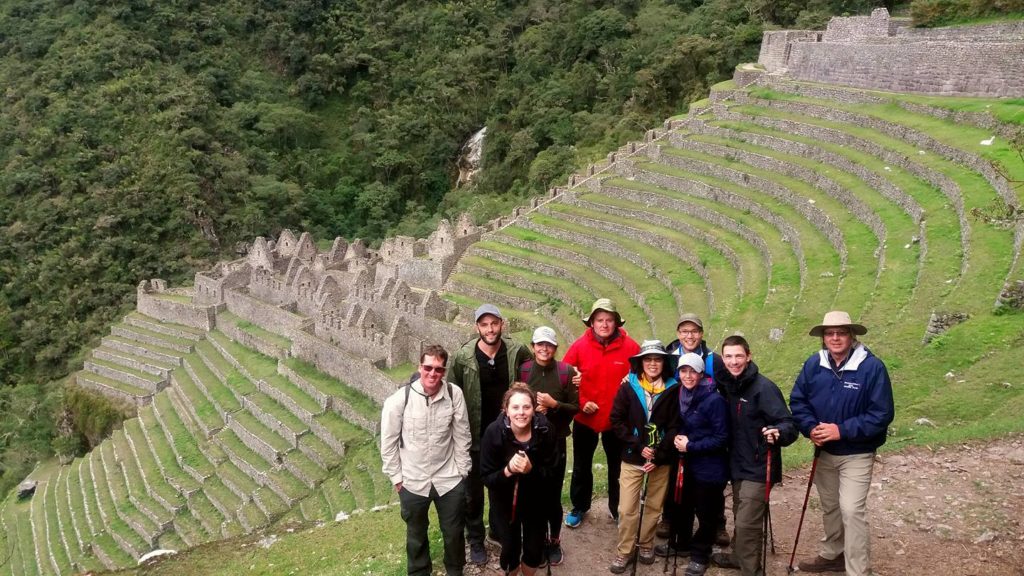
‘Say “Sexy Llama Team!'”: our lovely group at Winay Huayna
Inca Trail Day Four: Machu Picchu
Day four began at ungodly hour of 3am. Most trekkers want to see the sunrise over Machu Picchu from the Sun Gate, but the park doesn’t open til 5, so the different groups line up and wait in the dark until the gates open. I was so stiff that I could barely stagger, robot-like, to the checkpoint where I put my earplugs in, eyemask on and told Tom to wake me at 5. To say I was shattered doesn’t cover it, but once the gates opened, the excitement hit.
This part of the trek is notorious for having the potential to be unpleasant. Not due to the scenery, which was spectacular in the soft light of dawn, but because it can get so competitive (I’d read that some trekkers are so desperate to reach the Sun Gate first they elbow other hikers out the way, or even use their walking poles!). Because we were at the checkpoint first, we were the first team to be ‘set loose’, and the anticipation was catching. I wanted to share that iconic Machu Picchu sunrise with Tom and the rest of our group before hundreds of other trekkers arrived.
We upped our pace, but, as we speed-walked, we could hear the shrieks of the dreaded green team rising faintly behind us. It was like in Lord of the Rings when the hobbits can hear the screams of the orcs behind them: it inspired this desperate need to get away. It was the green team, after all, and who knows what they were capable of?? We later learned that they’d actually been violently shoving trekkers out of the way in their rush to pass; one guy was so aggressive he had to be separated from another trekker. This is all on a narrow cliff edge path without a guard rail. WTF.
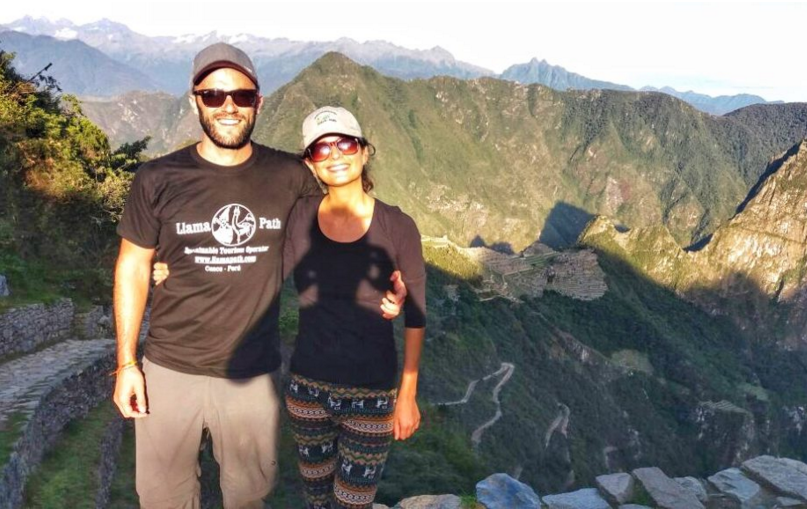
The view from the Sun Gate at 5:30am, Machu Picchu still in the shadows
Hearing the orcs green team approaching behind us, soon Tom and I were almost running. Looking back, it was just bonkers: one old Inca staircase on this last stretch is so steep you have to crawl up it on your hands and knees. The only person in front of us at this point was ‘bionic man’ Craig from our team, and we even passed him in our rush to escape – although this was only because Craig had layered up too much and, suddenly overheating, had to stop to strip off.
Something should have clicked in me then that I was pushing myself too hard. I’m unfit. I have no business overtaking anyone, especially proper hardy Aussie trekkers like Craig, who tell tales of giant, jumping-at-you grasshoppers like it’s no big deal at all. Craig, who after trekking to Machu Picchu decided hey, I’ll just do another trek while I’m here and pop up to the summit of Winay Picchu!
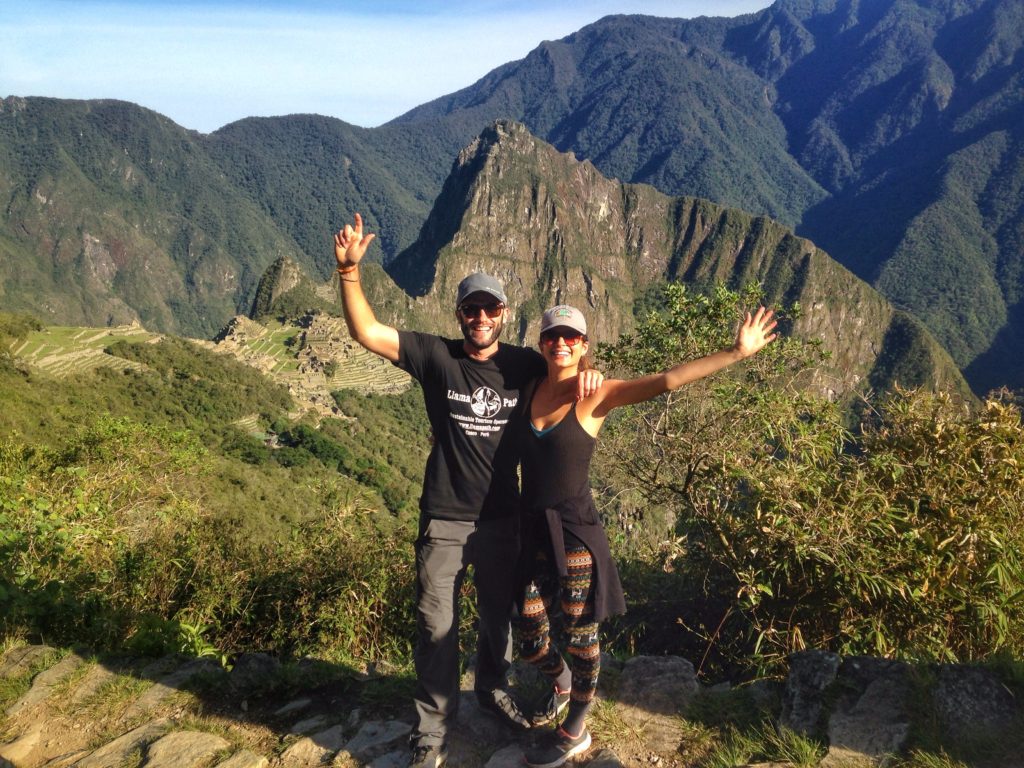
Whaddaya know – the sun rose!
But then, finally, we were there: pushing through the leaves into the riotous sunburst, gazing down at Machu Pichu below us. I was breathless and sweaty (Tom not so much), but despite that mad rush, it was so, so nice to have a few minutes before everyone else got there: just me, Tom, Craig and one other super speedy trekker from another group. It’s hard not to sound too wanky at this point, but it was such a special moment. We sat on the edge of the Sun Gate, grinning stupidly, looking down at Machu Pichu as the sun slowly revealed it in all its glory.
Though the views were incredible, I don’t think we even took more than a couple of photos at this point. We just wanted to look at the real thing and enjoy the quiet moment. And thank god we did, because after a short while we heard the whoops and “fuck yeahs!” of the green team as they approached. There was a brilliant moment where they didn’t see the four of us and, thinking they were the first ones there, started their usual shouting and high-fiving. When they saw us their faces dropped: “How the hell did you get here so fast? Way to crush our dreams.” Haha.
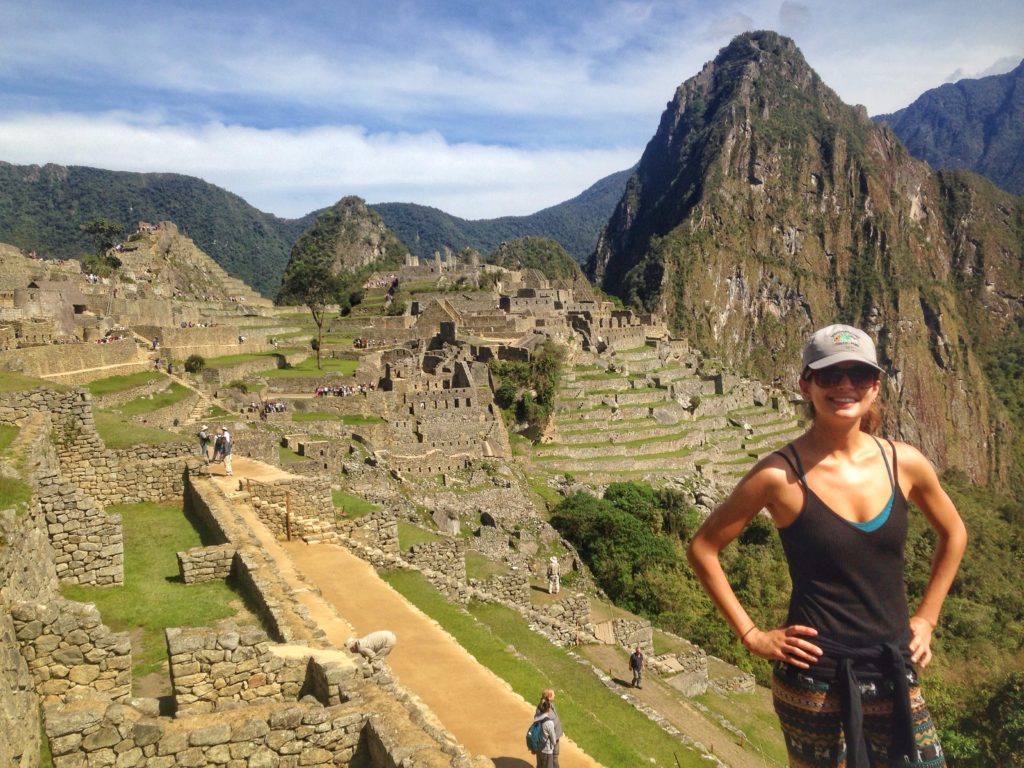
After a while we made our way down to Machu Picchu itself. Now it’s a given that it’s beautiful, the old Inca city sitting pretty on a jungly mountain peak. But Machu Picchu is the most beautiful place I have ever seen in my life. By a mile. I didn’t expect that. I’d seen the photos, but nothing could have prepared me for its beauty in real life. Every way you turn, every single angle you can think of, this entire area is jaw-dropping.
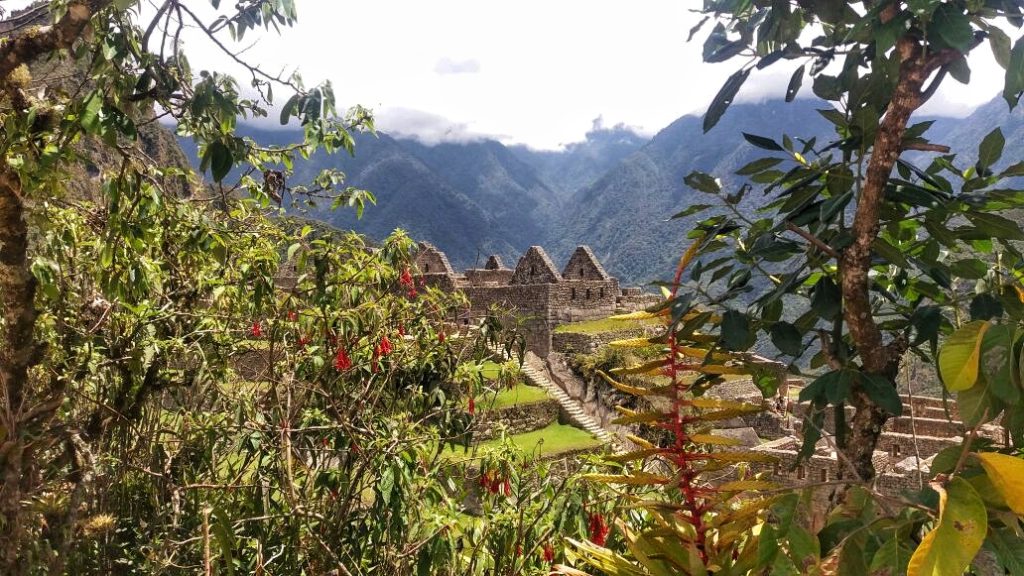
Our guided tour began, and this was the first point I felt something was wrong. The tour was so interesting, but all I could think about was how heavy my limbs felt, how weak I felt. I remember looking down at my feet climbing up the Inca steps to look out onto the valley bellow and feeling so spaced out I actually said to myself “I’m climbing steps at Machu Picchu.” I felt a genuine need to remind myself of that, because none of it seemed real. It was like being in a dream: I could hear the faint words of our guides drift around me like smoke, and the feel of my feet against the stone was all that was tethering me to the earth.

At that point, I was suddenly hit by the most powerful slap of exhaustion. Tom, like any sane person at Machu Picchu, wanted to explore. But by then I just couldn’t move, so crawled to a shady, grassy area underneath a rock. I’m a bit of an insomniac, so tiredness isn’t new for me. But this type of tiredness was, this physical tiredness where I felt I couldn’t even raise one leg.
When Tom hadn’t come back for me after ten minutes, I pulled myself up and saw him frantically waving at me from the other end of the site. I had no idea why he was over there, but as I tried to stagger over to him via the short way round, a security guard stepped in. Turns out Machu Picchu a one way system: they wouldn’t let Tom back for me, and I could only go forward, along the long, stepped paths and through the heaving throngs of tourists.

I stumbled past people, trying to push my way through to Tom, beginning to panic when I couldn’t get through. When I looked around it was like looking through a dense fog, and my legs were shaking so badly I don’t know how I didn’t fall. As I tried to slip past another group of tourists with selfie sticks, something squeezed tight around my heart. I’d never hyperventilated in my life, but soon I was shaking, full on crying, gasping for breath like a fish out of water. I must have looked like an absolute lunatic.
I’ve since learnt what happened was an exhaustion-induced anxiety attack brought on by several factors: four nights of less than 4 hours sleep a night combined with 11 hour hiking days; high altitude and thin air; heat; dehydration; and the general shock of pushing my unfit body through what amounts to a one hour mountain sprint before 6 in the morning on that final stretch.
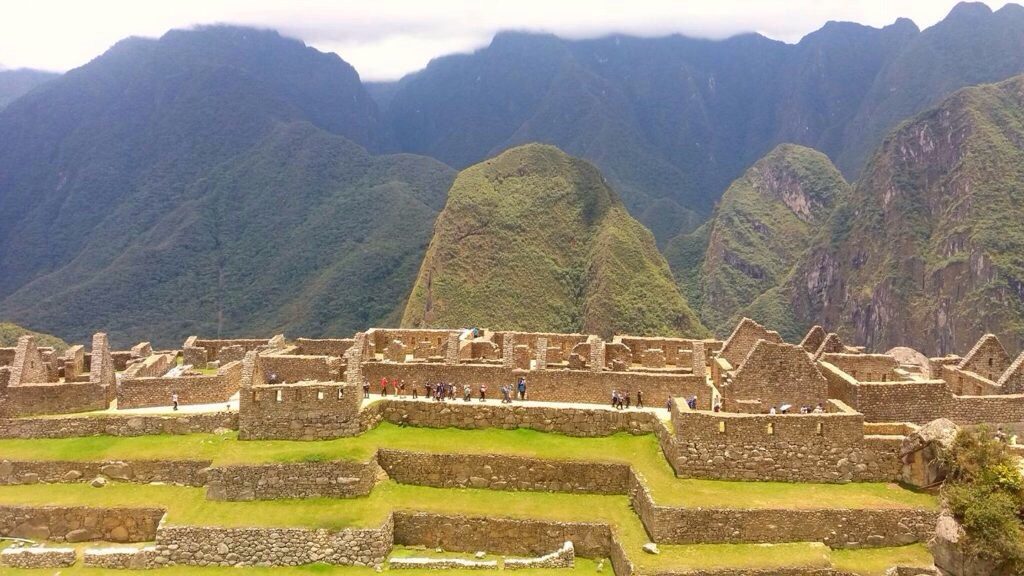
The only good thing that came of it was that I was in such a state we bypassed the queues to get out. The line for the bus would have taken an hour, but the security guy took one look me and shoved me on the bus. I’ll never forget the embarrassment of walking into our team meeting point to meet our lovely guides, still sobbing, still breathing like Darth Vader, their stunned faces floating in front of me. It took next hour to stop the hyperventilating, the rest of the day to feel normal again.
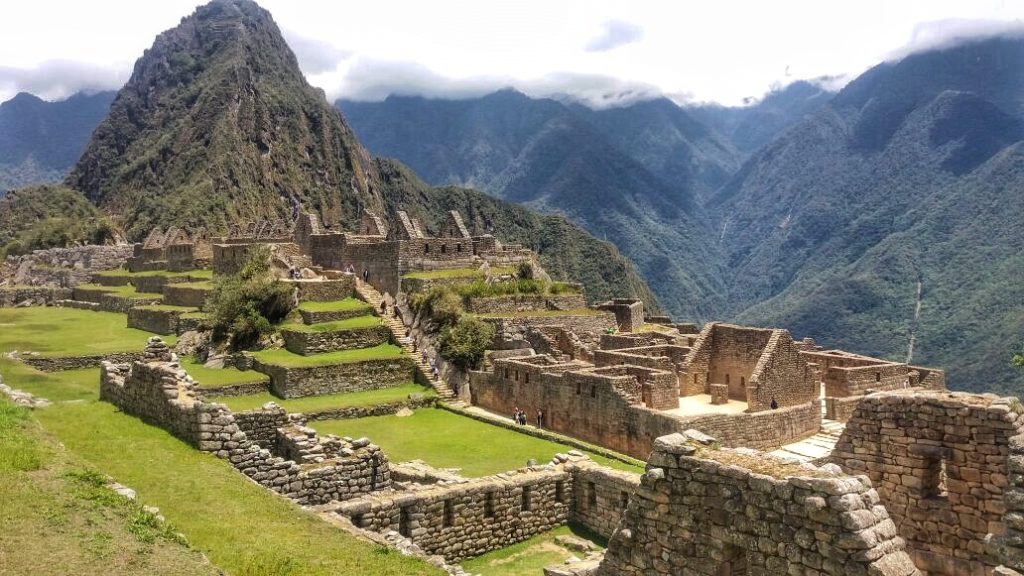

Now, there’s no question that this was all my fault. I wondered if I should even include it into this post because it was so unavoidable, but the final day will always be tarred with the experience of my only anxiety attack in 28 years. It’s a reminder that, while the Inca trail is totally doable, unless you’re very fit or used to this type of trek and altitude, it is hard work. And if you don’t take the right precautions, as I clearly didn’t, it can be a shock to your body.
In the end, even my meltdown had its positives. As a naturally lazy person, I’m not used to pushing myself in any real way. Knowing that I had pushed my body to both its physical and emotional limits was strangely satisfying. But still, don’t be like me. Walk the last stretch, no matter how annoying the team behind you are. Get enough sleep. Drink enough water (there’s none at the main site!). Take it slow and you can explore Machu Picchu at your leisure, rather than having a few snatched hours that still seems unreal looking back. (Poor Tom, who had to leave early too!)
Despite having months and months of travel ahead of us, I can’t even imagine doing something as amazing as this. I can’t imagine seeing scenery so stark, so beautiful, so pervaded with such fascinating ancient history. For all its ups and downs, the Inca trail remains the most incredible activity I’ve ever done, the most rewarding and gruelling experience of my life.
Is it worth the hype? Hell YES.


